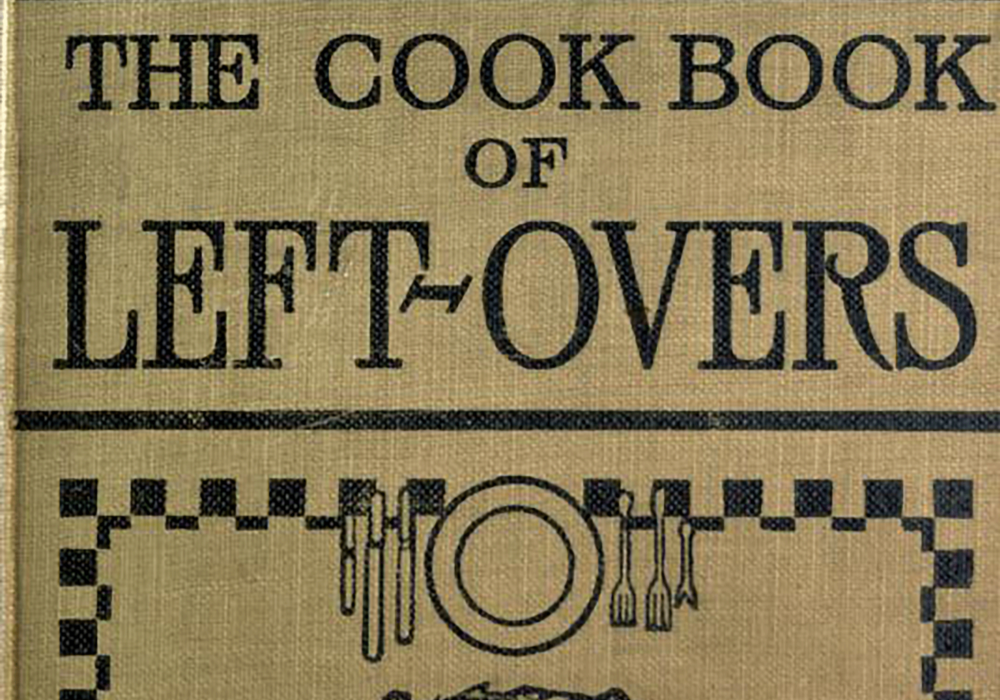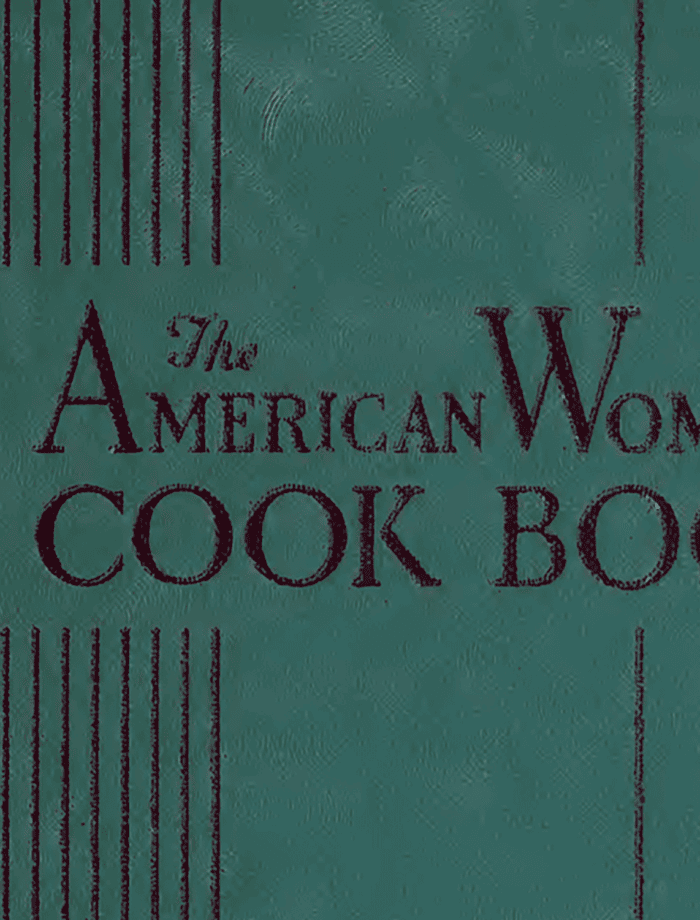As you all know, reducing waste in the kitchen constitutes the central ethos of Closed Loop Cooking. Living in an era of climate crisis and inequitable food systems, making the most of what we have in our pantries and refrigerators is one small way for us to practice responsible global citizenship. Beyond that, we are committed to centering the pleasure of food. We know that the joy of caring for yourself and others with a good meal is just as critical an aspect as the effort we put into our eco-conscious habits.
This week, I called upon our trusty Internet Archive to research what low-waste cooking looked like in American family kitchens throughout history (or rather, that which was documented by mainstream publishers i.e. mostly white and middle to upper-middle class). And if I were to summarize my findings, I would say that in large part, we’ve been trying to solve the same problems for decades. Whether you were cooking for a family during the turn of the 20th century, the Great Depression, the Reagan Era, pre-COVID 2019, or right now in 2023, the question of how best to use up your food persists.
The Cookbook of Leftovers: A Collection of 400 Reliable Recipes for the Practical Housekeeper
Written by Helen Carroll Clarke and Phoebe Deyo Rulon in 1911, identifies itself as “A practical handybook for the average housekeeper, who cannot afford to waste food which has been left over from her table, and who nevertheless desires to serve the best and most attractive dishes.” From the start the book describes the arduousness of cooking for a hungry family, and aims to “spare time and labor for the cook” by “making the most and best of a leftover food supply.”

Though refrigeration technology has improved since the time of publication, Clarke and Rulon’s attitude toward preventing food waste still rings true:
“During warm weather, when vegetables are most abundant, great care should be taken not to allow them to accumulate in the ice-box or pantry, as they spoil quickly after being cooked. As a general rule, they are not injured, either in digestibility or flavor, by rehearting, and as they are an expensive item in the food bill, especially in cities, they should never be wasted. Even a spoonful or two of almost any cooked vegetable will help to flavor a soup or sauce.”
Their advice on using and storing fruit could just as easily be a #homestead how-to video on TikTok:
“With sugar added and long cooking, almost any fruit can be made into a good jam for future use. Only perfectly sound, fresh fruit is safe to can. Canned fruit when opened spoils more quickly than any other cooked fruit; it is therefore wise always to use any remainder as soon as possible. It can be rubbed through a sieve, a little corn-starch added for thickening, made sweeter if necessary, and cooked until it thickens, and used as a sauce for puddings. It can be molded in a corn-starch mixture, added to a muffin batter and baked, or stirred into ice-cream.”
If you’ve ever fancied a lunchtime grain bowl, you understand the time-saving power of a batch cook:
“Most cereals are improved by long, slow cooking. This is emphatically true of hominy, cornmeal, and oatmeal, any one of which may be reheated to advantage. It is wise, therefore, to plan always for a remainder when cooking them. They are a comparatively cheap food, and when so cooked as to yield their full nutritive value, they form an important part of the dietary. They lend themselves easily to many transformations, and so give variety to the daily menu.”
‘Rice with Apples’ might not be one of the many transformations to come to mind today, but with a glass dish and candied cherries on top? It’d sure be a charming addition to a dessert spread at your next potluck:

Cooking on a Ration; Food is Still Fun
By Marjorie Mills, was published in 1943 — a frightening and disorienting time for homemakers, who had to radically reconfigure what and how they cooked based on a newly implemented rationing system. I imagine the anxiety that mothers must have felt about keeping their families nourished during Great Depression wasn’t all that different from what we experienced during early COVID days. Though obviously smaller in scope and duration, there was a period when we really couldn’t be certain when grocery stores would be restocked and whether it would be safe to enter them when they were.
Just as we turned to the whimsy of pet sourdough starters and dalgona coffee, Mills encouraged 1940s home cooks to turn to food as a source of enjoyment:
“We’re determined to do what’s asked of us, conserve our precious food supply, make it stretch to help feed the hungry… Does that mean food has to be less fun? On the contrary. We may be turning the page to a new and exciting chapter in American cuisine for the very reason that we’ll work over the foods we do serve with care and concentration.”
Our current-day perception of this time period as one of severe austerity is turned on its head by Mills’s spirited encouragement:
“In this troubled universe it’s more than ever important to make mealtime loom up as a little island of serenity and contentment… It can be done — but it takes wit and wisdom. We’re urged to grow and eat many more vegetables, but if the same limp and dejected vegetables trail across the dinner table, it will be a sawdust path of duty. (Sorry to scold but the way some people cook vegetables is scandalous. It’s no wonder families rebel.)” No 👏 more 👏 sawdust 👏 path 👏 of 👏 duty 👏
May we all bring such passion to salad preparation. If you’re not quoting French philosophers about it, you’re doing something wrong:

Half a Can of Tomato Paste and Other Culinary Dilemmas
During the comparatively indulgent 1980s, chefs Jean Anderson and Ruth Buchan published Half a Can… As can be inferred by its title, the book gives advice on what to do with “those partly used foods, most of them packaged, that have plagued us forever — the dribs of heavy cream souring on the refrigerator shelf, the orphaned egg yolks, the half cans of tomato paste and pimientos; the bullet hard raisins, quick-staling whole-grain flours, and lumpy brown sugars that clutter cupboards and invite insect attack.”
Quite honestly, not many of the recipes in this “lexicon of leftovers” were particularly appealing or unique. But the focus on using up packaged and processed goods speaks to the emergence of what was then a fairly new category of confusion in the kitchen — industrially produced and packaged food:
“So many of the staples that we consider nonperishable (corn meal, corn starch, brown sugar, dates, and raisins, for example) do in the end become non-palatable and non-usable if not actually spoiled.” The authors recommend dating packaged foods the day of purchase so as to: “Know when we should begin using them up in earnest, before they reach the point of no return (become rancid or buggy or so stale that no amount of seasoning can camouflage their elderliness).”
More cookbooks today might include mention of how to handle leftover packaged ingredients, but this observation is still relevant as ever:

The Nimble Cook: New Strategies for Great Meals That Make the Most of Your Ingredients
Chef and educator Ronna Welsh focuses on incorporating strategies that minimize waste in her 2019 book.
“I want to show you how to do amazing things with the food you have on hand — no matter how much or how little. This sometimes means dropping typical expectations of what constitutes a meal. The preconceptions can stop us from recognizing the makings of one when we have it. Consider this: A great meal doesn’t have to be any more than an assembly of fresh, delicious things to eat. For the nimble cook, a meal is sometimes several different, simple-to-assemble plates of food for all to share, the separate dishes tied together with little more than good conversation.”
Her three-step approach suggests looking at what you have and letting that jumpstart your meal plan:
1. Take stock: Look at what you might be missing in your fridge (e.g. specialty condiments, boxes of pasta, a few loose carrots, pickles, etc.) and let those take the lead on what you’re going to make
2. Create starting points: Prep ingredients so they can be used in many different ways (e.g. slicing an onion, washing and storing greens, toasting nuts, making dressing, etc.)
3. Turn starting points into creative meals
She reframes the leftover odds and ends as sources of inspiration:

The Everlasting Meal Cookbook: Leftovers A-Z
Rounding out this history of scrappy cooking is Tamar Adler’s newly released masterpiece. Published just last month, the book is a love letter to ingredients oft left behind. It’s chock full of ideas for leftover vegetables and their stems and leaves, recipes for overripe and underripe fruit and their peels and pits, guidelines for every type of grain, and more.
As introduction, Adler writes:
“Most of the time, we can trust our senses. Our meticulous olfactory instruments are also at work when water boils and greens begin to fry. I’ve used standard time estimates in most of these recipes, in addition to saying what you should listen and smell for, so you now how long it will be until dinner is ready. Please let your observations remain the arbiter. Only you know if a thing is ‘done’ or ‘good.’ And you know it through your eyes and ears and nose and mouth.”
We heartily endorse this book as well as her 2012 manifesto, An Everlasting Meal: Cooking with Economy and Grace. Either would be an exceptionally good mother’s day gift for any frugal foodie caretakers in your life.
I’m planning on whipping up a batch of this curry on Sunday for a few easy nourishing meals throughout the week to come.




